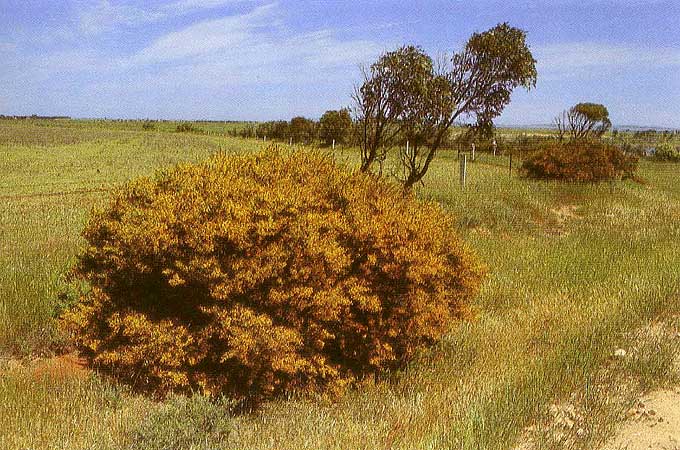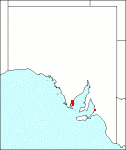Family: Fabaceae
Acacia whibleyana

Derivation: whibleyana in honour of Mr D. J. E. Whibley long time member of the State Herbarium of South Australia and the author of the first edition of this handbook.
Synonymy: Not Applicable Common name: Whibley wattle
Description:
Dense shrub 1.5-2.5 m tall, spreading 2.5-4 m diam. Branchlets angular at first but soon terete, glabrous, old phyllode-scars raised, prominent. Stipules caducous, not seen.
Phyllodes elliptic to oblanceolate, more or less asymmetric, tip curved to rostriform, occasionally straight, apiculate, tapered to the 0.5 mm pulvinus, blades 9-27 mm long, 2.5-7.5 mm wide, 2-4.5 times longer than wide, rigid, thick, ascending, mostly straight, occasionally slightly curved, glabrous, dull mid-green; veins numerous, fine, immersed, anastamoses infrequent; gland small, inconspicuous, near blade/pulvinus junction.
Peduncles (5-11 mm long, 2 per node, glabrous, slender; basal peduncular bracts persistent until about artthesis, more or less semicircular, ciliolate; heads globular, bright golden, 2.5-3 mm diam., 18-19-flowered; bracteoles spathulate, ciliate. Flowers 5-merous. Sepals petal length, free, oblong-oblanceolate. Petals elliptic, free, glabrous, spreading. Ovary minutely puberulous.
Legumes narrowly oblong, slightly raised over but not constricted between seeds, to 4.5 cm long, 4-7.5 mm wide, coriaceous more or less curved to smooth, glabrous, apiculate at apex, margins more or less thickened. Seeds obliquely arranged in pods, oval, 2.5-3 mm long, 2-2.2 mm wide, 1.2 mm thick, subglossy, dark pleurogram U-shaped; areole raised; aril large, formed by two apical loops of fleshy funicle.
|
|
Distribution:
|
This species has a restricted distribution and has been collected in an area within 40 km of Tumby Bay on southern Eyre Peninsula. It has been collected from loamy soils over limestone, sometimes near salt swamps.
S.Aust.: EP.
|
Flowering time: August, with fruits mature in December — January.
|

SA Distribution Map based
on current data relating to
specimens held in the
State Herbarium of South Australia
|
Biology:
No text
Related taxa:
Related to the Acacia lineolata complex (mainly Western Australia) and to A. ancistrophylla var. lissophylla which occurs on Eyre Peninsula and which differs in its narrower phyllodes of different shape, shorter peduncles with red resin hairs and narrower pods with longitudinal seeds.
Taxonomic notes:
I am grateful to R. S. Cowan & B. R. Maslin of the Western Australian Herbarium who generously provided me with description and information on this species before they had published it so it could be incorporated in the handbook.
Cultivation:
Not known in cultivation but would appear to be a useful dense shrub of medium size for moderate rainfall areas.
Author:
Not yet available
Source:

|

